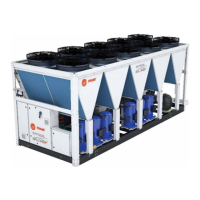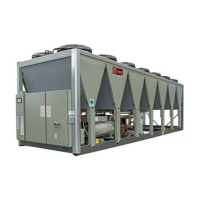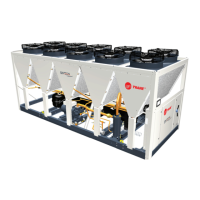11UNT-PRC002-GB
Sound power levels
Discharge
Measurement conditions:
Measurements taken in a room adjacent to the room containing the FWD, at the outlet of the rectangular duct (1.5 m
long) fixed to its discharge opening.
Fan Power level in dB(A), per Hz frequency band Overall power
Unit speed 125 250 500 1000 2000 4000 8000 dB(A)
1 55 50 42 37 37 31 30 46
FWD 08 2 57 54 47 40 30 38 40 50
3 58 57 50 42 32 40 43 53
1 57 51 45 42 34 33 28 48
FWD 10 2 58 54 48 45 38 39 35 51
3 60 58 50 48 40 42 39 54
1 57 51 45 42 34 33 28 48
FWD 12 2 58 54 48 45 38 39 35 51
3 60 58 50 48 40 42 39 54
1 56 62 50 48 39 38 36 56
FWD 14 2 61 66 55 53 47 46 45 60
3 63 69 58 56 50 50 49 63
1 57 63 51 49 40 39 37 57
FWD 20 2 61 66 55 53 47 46 45 60
3 63 69 58 56 50 50 49 63
Intake
Measurement conditions:
Measurements taken at the horizontal air intake.
Fan Power level in dB(A), per Hz frequency band Overall power
Unit speed 125 250 500 1000 2000 4000 8000 dB(A)
1 56 55 55 53 46 45 42 57
FWD 08 2 63 62 60 60 53 53 53 64
3 66 65 63 62 56 55 57 67
1 62 58 55 58 51 48 44 61
FWD 10 2 66 63 60 62 56 55 52 66
3 70 67 63 65 59 59 57 69
1 62 58 55 58 51 48 44 61
FWD 12 2 66 63 60 62 56 55 52 66
3 70 67 63 65 59 59 57 69
1 66 65 65 65 57 50 46 68
FWD 14 2 73 72 69 71 64 59 57 74
3 78 76 73 75 69 64 63 78
1 68 72 64 64 56 52 50 69
FWD 20 2 76 76 68 71 65 61 61 75
3 78 79 71 74 69 66 66 78
CG-SVX051A-GB
61
Compressor Service Information
Compressor Electrical Connections
It is very important that DSH compressors used in
the unit are wired correctly for proper rotation. These
compressors will not tolerate reverse rotation. Verify
correct rotation/phasing using a rotation meter.
Proper phasing is clockwise, A-B-C. If wired incorrectly a
DSH compressor will make excessive noise, will not
pump and will draw about half the normal current. It will
also become very hot if allowed to run for an extended
period.
Notice: Do not “bump” the compressor to check rotation
as incorrect rotation could cause compressor motor
failure in as little as 4 to 5 seconds!
Oil Level
To check compressor oil level, refer to the label near the
compressor sight glass. The compressor(s) must be off.
Wait three minutes. With tandem or trio compressors
the oil level will equalize after shutdown. Compressor
oil level should be no lower than the bottom of the
sight glass and no more than a full sight glass. When
operating, each compressor in a tandem or trio set may
have a different oil level. The oil level may not be in the
sight glass, but it must be visible through the sight glass.
Oil Fill, Removal and Capacity
The Model DSH compressors have an oil charging
valve with a dip tube that goes to the bottom of the
compressor. This can be used to add or remove oil from
the compressor.
Care must be taken to prevent moisture from entering
the systems when adding oil. Note that the POE oil used
in this product is very hygroscopic and easily absorbs
and retains moisture. Moisture is very difficult to remove
from oil using vacuum. Also note that once the seal on a
container of POE oil is opened, the oil must be used.
Use only Trane OIL00057E (3.8 l) or OIL00058E (18.9 l).
These are the same oil but different container size. Do
not use any other POE oil.
NOTE: Never reuse oil.
Oil Testing
We recommend performing a complete oil analysis at
least once a year with the Trane laboratory specifically
dedicated to oil analysis for Trane equipment. It provides
an in-depth view of both compressor and
refrigerant circuit conditions including presence of water,
wear particles, viscosity, acidity or dielectric data. If
unacceptable wear conditions develop, a change in the
characteristics of the oil will be evident. Minor problems
can be detected and repaired before they become major
problems.
Oil Equalizer Line
Scroll Compressors
The oil equalizer line is equipped with a Rotolock fitting
for easy removal. Torque value for tightening these fitting
is 145 N.m. Recover the system refrigerant charge and
Drain the oil to a level below the oil equalizer tube fitting
before removing the oil equalizer line. This must be done
on both compressors. Use the oil drain valve on the
compressor. If the oil is drained below the level of the
oil level sight glass, it will be below the oil equalizer line
level. Pressurize the low side of the compressor using
nitrogen to help drain the oil. No more than 70 kPa of
pressure will be needed.
Tandem and Trio Compressor
Suction Restrictors
Since most tandem and trio compressor sets use
unequal size compressors, these combinations require
the use of a restrictor in the suction line of one or more
compressors in order to provide correct oil level balance
between compressors when they are operating.
Compressor Replacement
If the unit suffers from a failed compressor, use these
steps for replacement:
Each compressor has lifting eyes. Both lifting eyes must
be used to lift the failed compressor. DO NOT LIFT A
COMPRESSOR USING A SINGLE LIFTING EYE. Use
proper lifting techniques, a spreader bar and rigging as
for lifting both compressors simultaneously.
After a mechanical failure of a compressor, it is
necessary to change the oil in the remaining compressor
and also replace the liquid line filter drier. After an
electrical failure of a compressor, it will also be
necessary to change the oil in the remaining compressor,
replace the liquid line filter drier and add a suction filter
drier with clean-up cores.
Note: Do not alter the refrigerant piping in any way as
this can affect compressor lubrication.
Refrigerant System Open Time
Model CMAF Multi-Pipe units use POE oil and therefore
refrigerant system open time must be kept to a
minimum. The following procedure is recommended:
• Leave a new compressor sealed until it is ready to
be installed in the unit. Maximum system open time
is dependent upon ambient conditions, but do not
exceed one hour open time.
• Plug the open refrigerant line to minimize moisture
absorption. Always change the liquid line filter drier.
• Evacuate the system to 500 microns or below.
Do not leave POE oil containers open to the
atmosphere. Always keep them sealed.

